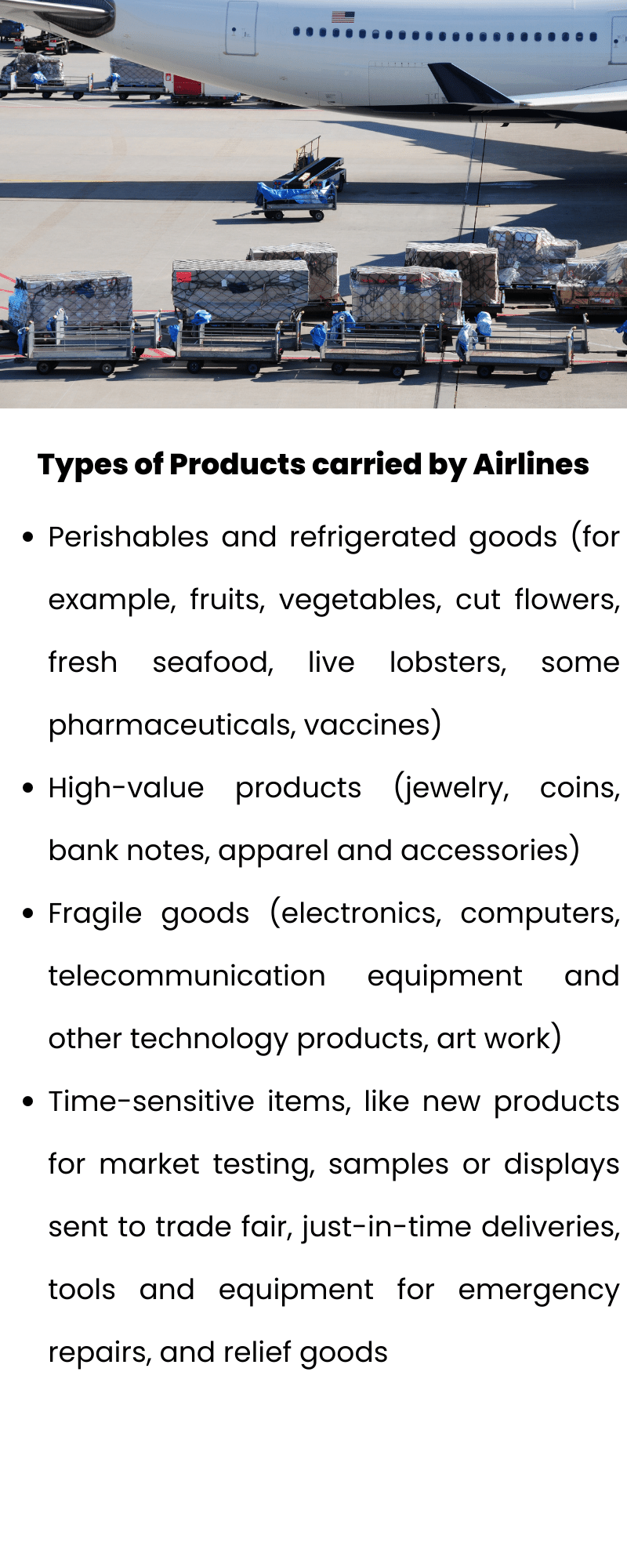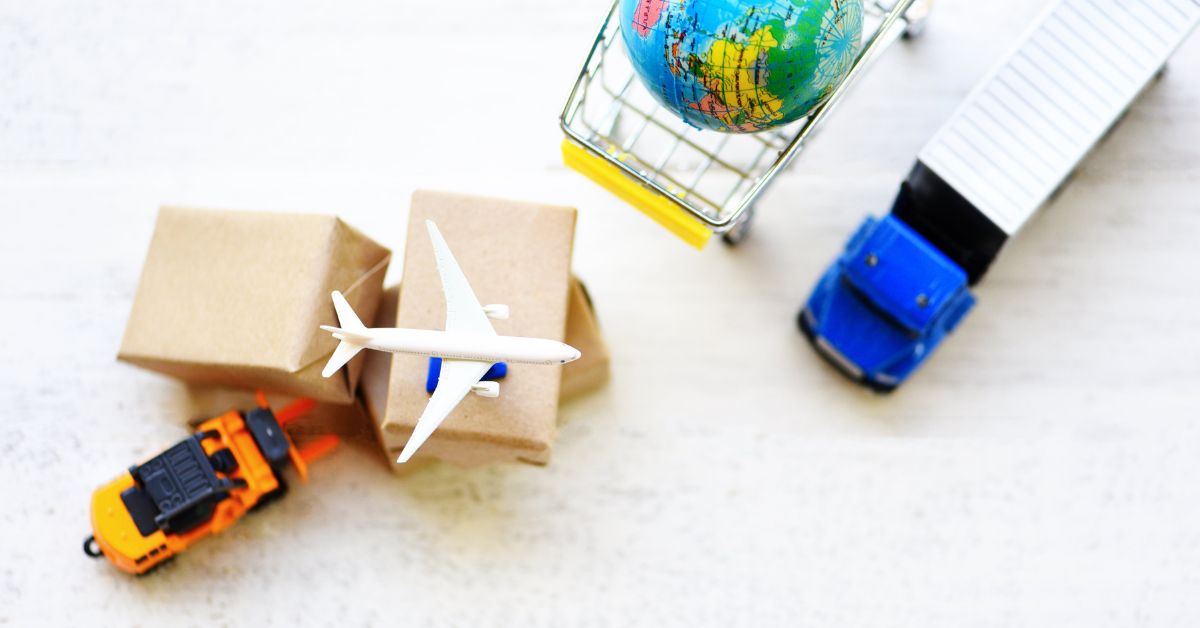Products Carried by Airlines include:
- Perishables and refrigerated goods (for example, fruits, vegetables, cut flowers, fresh seafood, live lobsters, some pharmaceuticals, vaccines)
- High-value products (jewelry, coins, bank notes, apparel and accessories)
- Fragile goods (electronics, computers, telecommunication equipment and other technology products, art work)
- Time-sensitive items, like new products for market testing, samples or displays sent to trade fair, just-in-time deliveries, tools and equipment for emergency repairs, and relief goods.
Table of Contents
- Shipment Size
- Products Carried by Airlines Valuables
- Temperature Variations
- Altitude Pressure Variations
- Products Carried by Airlines Perishables
- Dangerous Goods
- Lithium Batteries
Let us see the parameters to look into when exporting and importing through airlines:
Shipment Size
In air freight, knowing the measurements of a shipment is more critical than with other modes of transportation.
For example, if it is impossible to load the package through the cargo door of an aircraft, then it cannot be shipped by regular air freight. To note, one of the main elements to watch for is height; the rule of thumb is that as soon as the cargo exceeds 60-in in height, there is a need to look for a freighter service.
Likewise, if a shipment is particularly heavy (dense), it may need to have its mass spread over a larger area through the use of pallets or some other means. Failure to do so could cause dangerous stresses to the aircraft framework.
Another consideration is to ensure that the cargo can be accommodated on the unit load devices (ULDs) of the airline(s) being used for the shipment.
Products Carried by Airlines Valuables
Any shipment with a known value of over USD $1,000.00/kg is considered a valuable shipment, regardless of the commodity.
In addition, the following commodities are always considered valuable shipments:
- Gems, gold, artwork, silver, pearls, furs/pelts, jewellery, narcotics and controlled drugs, watches
- Negotiable paper, including money or currency notes, stocks and bonds, travellers cheques.
When a shipment meets the definition of valuable cargo, its class will determine handling requirements; classes represent the known value of the shipment.
Temperature Variations
Airlines do maintain refrigerated storage units (walk-in refrigerators in cargo handling warehouses) and offer refrigerated cargo units (containers).
Also some airlines and/or their truckers provide temperature-controlled vehicles for the dispatch of perishables during extremely cold or hot weather.
The airlines do make every effort to keep exposure of the cargo to extremes of temperature and adverse weather conditions to an absolute minimum.
It is also important that shippers be aware of the general temperature variations between the points of origin and destination, and that most containers and pallets are stationed in advance near the passenger loading gate for some time prior to loading of the aircraft.
Temperature ranges from -40°C to +55°C could be encountered during transit. To prevent damage to temperature-sensitive cargo, the use of temperature-controlled containers is recommended.
Altitude Pressure Variations
The cabin interior of an all-cargo jet is normally pressurized to a level equivalent to that of between 5,000 and 8,000 ft above sea level.
The cargo compartments of combination aircraft are normally pressurized to the 8,000-ft level, creating a pressure differential of four lb/in2 compared with sea level. This is a suitable pressure for baggage, mail and most solid freight, but may be unsuitable for certain liquid cargos.
Under extreme conditions (e.g., in non-pressurized cargo compartments), the pressure reduction can reach a differential of eight lb/in2 as compared with sea level, which can affect certain liquid cargos unless they are adequately sealed. Sufficient room for the expansion of liquids should always be allowed within the container (can or bottle).
Products Carried by Airlines Perishables
Different types of perishable goods have their own ideal temperature for transport and storage. Packaging must be able to accommodate these temperatures.
The air carrier’s cargo representative can provide detailed packing instructions so that the ideal transport temperature can be maintained for that type of cargo.
Temperature control is the single most important factor in guaranteeing the fresh arrival of perishable goods.
Most cargo terminals provide such facilities, but it is important to check with the chosen airline whether the destination airport is equipped with such a facility and to use temperature-controlled containers, when available.
Dangerous Goods
Most goods that are classified as dangerous under the IATA/ICAO Dangerous Goods Regulations can be safely transported by air provided that the IATA/ICAO Dangerous Goods Regulations are strictly adhered to with respect to a number of limitations for carriage, packaging, quantities, etc.
Some dangerous goods are too dangerous to be carried on passenger and cargo aircraft; others may be carried only on cargo aircraft and/or in limited quantities.
Lithium Batteries
Lithium batteries carried on an aircraft could pose a serious threat to aircraft safety. Lithium batteries are classified as miscellaneous dangerous goods.
There are various types of lithium batteries, and they can be carried inside a piece of equipment, separately with a piece of equipment or on their own.
The IATA/ICAO Dangerous Goods Regulations must be strictly followed, especially with respect to shipping quantities, proper packaging and documentation.

